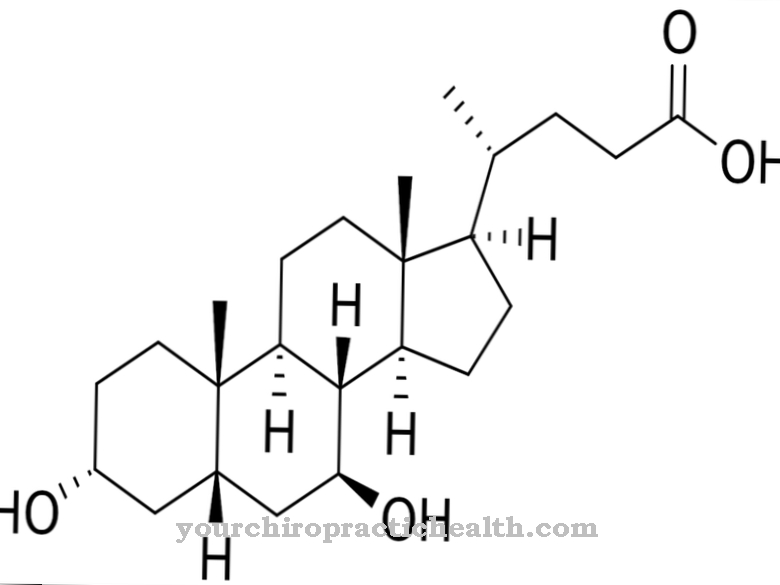Streptomycin is an aminoglycoside antibiotic with a broad spectrum of activity against gram-negative and gram-positive bacteria. The antibiotic is synthesized by aerobic bacteria of the genus Streptomyces that live in the soil and form a large family and belong to the actinobacteria. Because of its undesirable side effects and the risk of developing resistance, streptomycin is mainly used to combat tuberculosis and endocarditis if the inflammation was caused by streptococci or enterococci.
What is streptomycin?

Streptomycin is an aminoglycoside antibiotic that is synthesized by numerous bacteria belonging to the streptomycete family. The aerobic streptomycetes belong to the large group of actinobacteria. They also produce fragrances that give the fresh forest floor its characteristic smell. The chemical formula of streptomycin is C21H39N7O12.
The antibiotic has a broad spectrum of activity against gram-negative and gram-positive bacteria such as the tuberculosis pathogen and against infections and inflammations caused by enterococci and streptococci.
Streptomycin was first isolated in 1943 and was the first effective antibiotic against tuberculosis. The mechanism of action of the antibiotic is that it intervenes in the process of protein synthesis. By disrupting the docking of the transport RNA (tRNA) on the ribosomes, the bacterium synthesizes faulty amino acid sequences that are unusable for further growth.
Due to the established development of resistance and harmful side effects after prolonged use, streptomycin is mainly used against the causative agents of tuberculosis and brucellosis as well as against streptococci and enterococci. Streptomycin is also used as a combination preparation together with other antibiotics such as penicillin.
Pharmacological effect
The antibiotic streptomycin consists of the three sugars streptidine, N-methylglucosamine and streptose, which are glycosidically linked. In many gram-negative types of bacteria, cocci and mycobacteria, it has the property of being able to dock onto a specific protein in the ribosomes. It is a protein to which the tRNA normally docks, which is loaded with the amino acids required to build the protein. This process is disrupted by the streptomycin, so that either proteins can no longer be synthesized or those with the "wrong" amino acid sequence. As a consequence, functionless nonsense proteins can then arise, which prevent further growth of the bacteria.
The bacteria against which streptomycin is effective belong to the prokaryotes, in which the genetic material floats in the cytoplasm and is more easily accessible than in the eukaryotes, in which the genetic material (DNA) is located in the cell nucleus, which is separated from the cytoplasm by its own membrane is. Since streptomycin is only found in the extracellular space, it is only effective against germs that are also in the extracellular space. This also explains the selective effect of the antibiotic. The degradation of streptomycin takes place renally, i.e. via the kidneys, but degradation substances accumulate in the body, especially in the inner ear in the cochlea and in the vestibular organs as well as in the kidneys, which explains the ototoxicity and nephrotoxicity.
Medical application & use
Streptomycin was found to be beneficial in the fight against tuberculosis after its introduction in the 1950s. However, the germs often developed resistance for a relatively short period of time, which drastically reduced the effectiveness of the antibiotic. Side effects suggesting inner ear and kidney toxicity did the rest.
With the development of alternative antibiotics, streptomycin has been greatly reduced and regulated in medical use. Nevertheless, the antibiotic still plays an important role in the use against certain pathogens and is usually administered in combination with other antibiotics.
One of the most important areas of application is inflammation of the inner lining of the heart caused by streptococci and enterococci. Streptomycin is usually given in combination with penicillin. Another important area of application is the control of the pathogens of the genus Brucella. There are a number of infectious diseases such as swine brucellosis or Mediterranean fever and others. Streptomycin is usually used in combination with tetracyclines to treat brucellosis. Streptomycin also still plays an important role in the fight against tuberculosis.
Basically, streptomycin can be administered orally or in the form of intramuscular injections. Due to the low absorption, oral administration is only effective for infections in the gastrointestinal tract, where it can develop locally. If systemic effects are required, streptomycin is injected intramuscularly to ensure rapid absorption. The antibiotic distributes itself quickly in the body fluids, but cannot cross the blood-brain barrier.
Risks & side effects
There are some risks associated with using streptomycin, and mild to significant side effects can be expected depending on the duration of therapy. The main risks of monotherapy with streptomycin consist in the relatively rapid development of resistance of the germs, which can even reverse the effect of the antibiotic, as the bacteria then metabolize streptomycin with energy gain and can also use it as a carbon source.
Another risk complex is linked to the possible side effects listed below, which can lead to irreversible damage to the inner ear and kidneys. Side effects that are often observed, especially with long-term use of streptomycin, include headache and eye pain, nausea and trembling eyes (nystagmus), developing inner ear hearing loss and dizziness caused by a damaged sense of balance (vestibular system). The cochlea in the inner ear (cochlea) is connected to the vestibular organs, the semicircular canals (rotational accelerations) and the otolith organs (translational accelerations) via the endolymphatic system within the membranous labyrinth.
Another risk is the occurrence of kidney dysfunction.
























.jpg)



